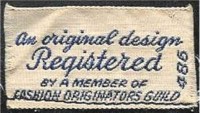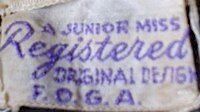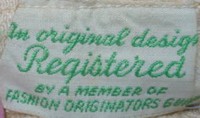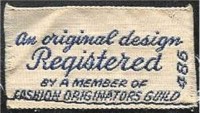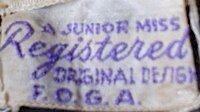Starting in In 1932, garment designers banded together to prevent design theft, commonly known as “knock offs”, by manufacturers. They formed the Fashion Originators Guild of America (F.O.G.A.) after help or protection was not forthcoming from Congress or the courts. A founding member and the first president of the Guild was Maurice Rentner.
The Guild was an association of manufacturers and retailers who pledged to only deal in original creations. If a retailer failed to abide by the provisions of the Guild, they would be included on a “red-card” which listed all “non-co-operating retailers”. Other Guild members were then forbidden to deal with them.
Although this system was effective in stemming the theft of garment designs, the Guild ran into trouble with the Federal Trade Commission in 1936. In 1941 the Supreme Court held that the Guild’s practices violated the Sherman Antitrust Act, thus ending the use of self-help trade restrictions.
Often a registration number is found on the label. It is not clear if the garment can be identified as to maker and year by use of the number. Thousands of designs were registered by over 100 designers and manufacturers over the course of nine years.
Written by pastperfectvintage.com





